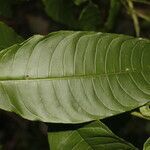Shrub or tree to 12 m tall; twigs green, slender, glabrous. Leaves mostly 10-15 cm long, ovate or elliptical, oblique, apically acute or acuminate, basally rounded or obtuse, the margins sometimes revolute, soft membranaceous, dark This content downloaded from 192.104.39.2 on Tue, 14 May 2013 16:07:58 PMAll use subject to JSTOR Terms and Conditions610 ANNALS OF THE MISSOURI BOTANICAL GARDEN [VOL. 60 green, glabrous when mature, the veins many, evenly spaced and arcuate on each side of the midrib, raised and conspicuous beneath; petioles short, to 2 cm long; minor leaves absent. Inflorescences many, congested, distributed along the branches, axillary or terminal; peduncles short, to 3 cm long, angled, mostly un-branched, lengthening to 9 cm in fruit; pedicels to 4 mm long with linear, 1 mm long bracteoles. Flowers with the calyx ca. 3 mm long, cyathiform, campanulate or short tubular, prominently costate or not, pubescent or glabrous outside, glabrous within, short-lobed; corolla yellowish or greenish, sometimes purple blotched, the tube 10 mm long, slender, opening gradually to the apex, glabrous outside, inside glabrous or pubescent, sometimes tomentose at the base, the lobes 3-4 mm long; stamens equal, the filaments 1.5-3 mm free, smooth and straight, often pubescent below, not tumid, barbellate or appendaged; stigma included. Fruit black, ca. 6 mm long, obovoid.
More
A shrub or small tree. It can grow 12 m tall. The leaves are simple and alternate. The leaf blade is 7-23 cm long by 3-7 cm wide. They are oval and taper to the tip. The flowering stalks can be in axils of leaves or at the ends of branches. There are many tube shaped flowers. They are mostly green. The fruit are 6-8 mm across. They are oval and black at maturity. There are several seeds.










